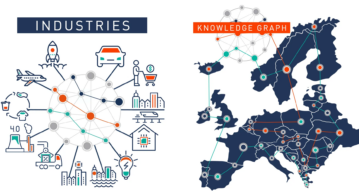Why automation needs more than robots — Catalytic shows the way
Henry Ford once said that every organization “should aspire to deliver the best products at the lowest cost possible, paying the highest wage possible.”
That basic ethos remains true, even in this highly digitized age. Most contemporary commentators would probably add a caveat or two of their own: HR professionals would want to add something about a creatively engaged and contented workforce, while cybersecurity teams would need some stipulation about working safely and without fear of data compromise.
But nevertheless, the goals of operational efficiency remain true, even while the means of reaching those goals have shifted. Today, of course, companies and organizations of all sizes are transforming digitally — using technology to make giant steps down the road to better operations, rather than the smaller steps that slower, 20th-century industrial processes provided. Most businesses now utilize multiple pieces of technology, sometimes designed to solve a particular issue (a so-called “point product”), or commonly, something designed to do many common activities all over the business, like a large ERP (think Salesforce, SAP, or NetSuite, for example).
RIP, RPA
Every organization’s mix of technology is different, and there are plenty of solutions out there that will help companies “join up” those discrete applications and services. This type of first-generation automation can often succeed in doing much of the “heavy-lifting” by removing many of the repetitive workflows that competing technology point products create. Moving data from A to B, from system X to System Y, for example, has its uses and will yield some gains in operational efficiency. But there are two significant downsides:
– Cost. Robotic process automation solutions themselves may not be cheap, and additionally, setting them up to work often involves expensive development teams skilled in API negotiation protocols, outside consultants, and connections between point products that don’t scale well, and are prone to breaking when systems are upgraded.
– Embedding inefficiencies. Once RPA solutions are emplaced, the business processes they automate are effectively immovable (or movable only with significant overheads and costs). Gathering, parsing, transforming, and transferring data between multiple systems may well be achieved faster than when humans did the job, but the issue of whether the process was the best way in the first place is often not considered.
Is there a magic silver bullet?
In the experience of most digital transformation experts, the whole concept of a silver bullet to solve the operational efficiency conundrum is all wrong. If we were hunting for a simile, a better one might be a silver boomerang; it implies an iterative approach that keeps circling back and solving, tweaking, attenuating, and, as it circles back around, allows an objective oversight onto the way the business is working as a whole.
Furthermore, what those same experts will be able to tell you is that the best designers for any business problem (silver bullet designers, if you like) are the people who work every day with or around a problem. The most efficient way to address those problems in the first instance is to equip those people with the tools they need.
That realization has led to the game-changing rise of the citizen developer, capable of creating applications that go over and above simple automation to create software entities that are changing the workplace. The low-code or no-code development environment lets those local subject experts, the people who work in a function day in, day out, to quickly produce solutions that make life easier — and by proxy, increase efficiency for the enterprise.
What’s low, and what’s no?
In “traditional” development circles, low-code and no-code development platforms often get a bad name. To be fair, the title of “no-code” is something of a misnomer. If we take Catalytic‘s development environment, which is a rules and data-based engine wrapped into an intuitive, outline-format GUI, we find that it is relatively simple to construct complexity, but it doesn’t possess magic powers (perhaps a later release may do…). Yet if you’re capable of writing an Excel macro, albeit a simple one, then creating an automation using the platform is attainable.
Because the software is placing very clever layers of simplification (developers: read “abstraction”) over what are often highly complex systems, the software does a great deal of the hard work in its interfacing with and automating of the many data points and systems that power the enterprise. Low-code might be a fitting description, but the outcomes are far from low-power.
The modular nature of next-generation software like the Catalytic platform means that what was once esoteric can now be everyday. Using artificial intelligence, for example, required a degree in Computer Science a few years ago (and thought processes that ran in Python). Now, many intelligent technologies can be applied as simple, pre-made building blocks that can be configured with a few clicks. For example, in Catalytic OCR and NLP can be leveraged to structure data—like documents in non-standard formats, virtual paperwork from different sources ranging from PDF, email and proprietary systems’ outputs—as just one module in a longer, integrated workflow, making intelligent features practical and providing a standardized data infrastructure for more advanced machine learning.
It’s in scenarios like those that operational efficiency gains can be made, ones that go beyond a simple, rote automated process, to one that’s crafted by the end-user or local expert, and is capable of flexibility and scaling. But there’s one more ingredient in the special sauce.
The oversight is the biggest game-changer
If we circle back to our “silver boomerang” analogy, there was mention of an objective view onto the whole of the business’s processes. Because to a machine “brain,” all processes, integrations, interactions, and automations are just data, it’s possible to gather in just about everything that’s happening in the enterprise, into one place.
The common thread is the Catalytic platform, which not only is being used from the ground up by the “citizens” of the business every day, but also by managers who can get a view of the overall way that the business is functioning via the Catalytic Insights panel. It shows not only what’s going on at any level of detail (zoom in for more information, zoom out for the broadest view), but therefore where the bottlenecks are and what processes might need attenuating. It’s the broader view of the organization’s activities via Catalytic Insights that is differentiating the latest generation of automation platforms from the older, RPA solutions that automate statically, with little sense of the bigger picture.
Conclusion
Optimizing any business for operational efficiency needs more than a technology platform. But what the latest iterations of software are showing is that the business processes that run every organization become more apparent to oversight once the software is created and implemented. The iterative nature of the business transformation process to better operational efficiency is a never-ending journey: businesses change, scale, and grow. The software that automates and empowers needs to adapt and flex and, at all times, create views onto the whole of the processes to allow better decisions taken at a larger scale.
With the Catalytic platform, every organization has a way with which the end-users get to create their own efficiencies and leverage the very best in new technologies and methods. The modular nature of the platform (and its pricing structures) lends itself to starting small — almost a “live” proof of concept exercise — and building up to develop that full, enterprise-wide automation solution.
Next month we’ll be exploring the subjects of efficiency and automation in more depth. But until then, check out the Catalytic offer of a free demo.









